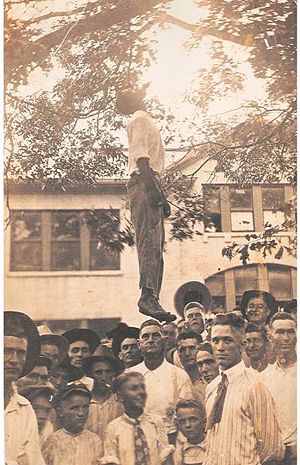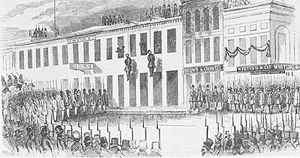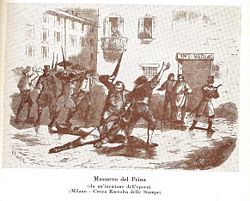Lynching
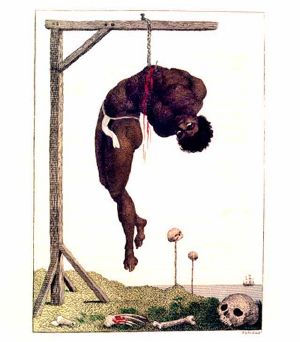
Lynching is a form of violence, usually murder, considered by its perpetrators as extra-legal punishment for offenders, or as a terrorist method of enforcing social domination. It is characterized by a summary procedure ignoring, or even contrary to, the strict forms of law. Lynching is sometimes justified by its supporters as the administration of justice (in a social-moral sense, not in law) without the delays and inefficiencies inherent to the legal system. Victims of lynching have generally been members of groups marginalized or vilified by society. The practice is age-old; stoning, for example, is believed to have started long before lapidation was adopted as a judicial form of execution. "Lynch law" is frequently prevalent in sparsely settled or frontier districts, where government is weak and officers of the law too few and too powerless to preserve order. The practice has been common in periods of threatened anarchy. In the early twentieth century, it was also found significantly in Russia and south-eastern Europe, but especially and almost peculiarly in America. When the debate over capital punishment itself has reached the level that many countries have abolished the death penalty even through the judicial process, the idea of lynching alleged offenders without any regard for their human rights can be understood as very wrong, and part of the dark history of humankind.
Etymology
The word lynching is recorded in English since 1835, as a verb derived from the earlier expression "Lynch law" (known since 1811). This phrase is likely named after the Lynch family name.
The most likely eponym for the concept of Lynch law as summary justice is William Lynch, the author of "Lynch's Law." This was an agreement with the Virginia General Assembly (Virginian state legislature) on September 22, 1782, which allowed Lynch to pursue and punish criminals in Pittsylvania County, without due process of law, because legal proceedings were in practical terms impossible in the area due to the lack of adequate provision of courts.
Others believe the term came into use only with Colonel Charles Lynch, a Virginia magistrate and officer on the revolutionary side during the American Revolutionary War. He continued William's practice as the head of a vigilance committee, an irregular court trying and sentencing (in the form of fines and imprisonment) petty criminals and pro-British Tories in his district circa 1782.
In these cases only minor punishments were used, mostly corporal punishment, especially flogging. Neither William Lynch nor Charles Lynch ever executed anyone.
Extralegal punishments similar to those adopted by both Lynches continued to be duplicated by others in the newly independent U.S. and elsewhere. The term "lynch law" came in to general use as a loosely employed description of efforts to maintain the established order either by the use of actual lynchings against those who would change it, or even their mere threat, which often proved sufficient to silence activists and critics. The term "Lynch mob"—for a group of private persons who collectively practice lynching—is attested from 1838. Since the Reconstruction Period after the Secession in the United States, the term came to mean, generally, the summary infliction of capital punishment. The further narrowing of the meaning to extralegal execution, specifically by hanging, is from the twentieth century.
An alternative theory of origin arises from a text called the William Lynch Speech, alleged to have been written in 1712, and attributed to one "William Lynch," a Caribbean planter and slave owner. This speech describes a plan to "break" and control slaves using intimidation and other methods. Though the speech is regarded by some historians as a fake, it has been cited numerous times by Louis Farrakhan and many others.
Another suggestion is that it came from Lynchs Creek, South Carolina, where summary justice was also administered to outlaws; some writers even attempted to trace it to Ireland, or to England. One unlikely theory traces it back to 1493 when James Fitzstephens Lynch, mayor and warden of Galway (Ireland), tried and executed his own son, but that would leave a transatlantic, centuries wide gap.
Social characteristics
There are generally two motives for lynchings. The first is the social aspect: Righting some social wrong or perceived social wrong (such as a violation of Jim Crow etiquette). The second is the economic aspect. For example, upon successfully lynching a black farmer or immigrant merchant, the land would be available and the market opened for white Americans. The terror and intimidation produced by lynching can effectively serve as weapons in economic warfare. This motive was particularly prevalent in the post-Civil War South in America. Because many supporters of the Confederacy were barred from holding public positions of power, they sought to assert themselves through this economic warfare, which took the form of lynching the newly empowered African-Americans. A black journalist, Ida B. Wells, discovered in the 1890s that black lynch victims were accused of rape or attempted rape only about one-third of the time. The most prevalent accusation was murder or attempted murder, followed by a list of infractions that included verbal and physical aggression, spirited business competition, and independence of mind. After accusing these people of crimes, the communities then felt justified in lynching them for a supposed public good.[1]
Many lynchings are carried out with the participation of law enforcement and government officials. Police might detain a lynching target, then release him into a situation where a lynch mob could easily, and quietly, complete their deed.[2]
Historical examples
United States
Lynching in the United States has influenced and been influenced by the major social conflicts in the country, revolving around the American frontier, Reconstruction, and the civil rights movement. Originally, lynching meant any extra-judicial punishment, including tarring and feathering and exile, but during the nineteenth century in the United States, it began to be used to refer specifically to murder, usually by hanging.
The San Francisco Vigilance Movement, for example, has traditionally been portrayed as a positive response to government corruption and rampant crime, but revisionists have argued that it created more lawlessness than it eliminated. It also had a strongly nativist tinge, initially focusing on the Irish and later evolving into mob violence against Chinese immigrants.
Lynch Law, a form of mob violence and putative justice, usually involving (but by no means restricted to) the illegal hanging of suspected criminals, cast its pall over the Southern United States from the mid-nineteenth to the mid-twentieth centuries. Before the Civil War, its victims were usually black slaves and persons suspected of aiding escaped slaves; lynching was mainly a frontier phenomenon. During Reconstruction, the Ku Klux Klan and others used lynching as a means to curb what they viewed as excesses within the Radical Republican Reconstruction government. Federal troops operating under the Civil Rights Act of 1871 largely broke up the Reconstruction-era Klan, and with the end of Reconstruction in 1876, white southerners regained nearly exclusive control of the region's governments and courts. Lynchings declined, but were by no means brought to an end. In 1892, 161 African-Americans were lynched.
On the American frontier, where the power of the police and the army was tenuous, lynching was seen by some as a positive alternative to lawlessness. In the Reconstruction-era South, lynching of blacks was used, especially by the first Ku Klux Klan, as a tool for reversing the social changes brought on by Federal occupation. This type of racially motivated lynching continued in the Jim Crow era as a way of enforcing subservience and preventing economic competition, and into the twentieth century as a method of resisting the civil rights movement.
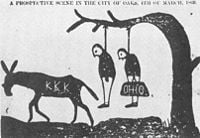
In 1915, three closely related events occurred: The lynching of Leo Frank, the release of the film The Birth of a Nation, and the reorganization of the Ku Klux Klan.
The 1915 murder of factory manager Leo Frank, an American Jew, was one of the more notorious lynchings of a non-African-American. In sensationalist newspaper accounts, Frank was accused of fantastic sexual crimes, and of the murder of Mary Phagan, a girl employed by his factory. He was convicted of murder after a questionable trial in Georgia (the judge asked that Frank and his counsel not be present when the verdict was announced because of the violent mob of people in the court house). His appeals failed and the governor then commuted his sentence to life imprisonment, but a mob calling itself the Knights of Mary Phagan kidnapped Frank from the prison farm, and lynched him.
The recreation of the Klan was also greatly aided by D. W. Griffith's 1915 film The Birth of a Nation, which glorified the Klan. The film resonated strongly with many southerners who believed Frank was guilty, because they saw an analogy between Mary Phagan and the film's character Flora, a young virgin who throws herself off a cliff to avoid being raped by the black character Gus. After the release of the movie, the Klan re-formed with a new emphasis on violence against immigrants, Jews, and Catholics. They used lynching as a means to socially, economically, and politically terrorize and paralyze these populations, in support of a white supremacist status quo. Lynch Law declined sharply after 1935, and there have been no reported incidents of this type since the late 1960s.
The murders of 4,743 people who were lynched in the United States between 1882 and 1968 were not often publicized. It is likely that many more unrecorded lynchings occurred in this period. Lynching statistics were kept only for the 86 years between 1882 and 1968, and were based primarily on newspaper accounts. Yet the socio-political impact of lynchings could be significant, as illustrated by the restoration in 1901 of capital punishment in the state of Colorado (which had abolished it only in 1897) as the result of a lynching outbreak in 1900.
Most lynchings were inspired by unsolved crime, racism, and innuendo. 3,500 of its victims were African Americans. Lynchings took place in every state except four, but were concentrated in the Cotton Belt (Mississippi, Georgia, Alabama, Texas and Louisiana).[3]
Members of mobs that participated in these public murders often took photographs of what they had done, and those photographs, distributed on postcards, were collected by John Allen who has now published them online [4], and written words to accompany the shocking images.
Mexico
On November 23, 2004, in the Tlahuac lynching, three Mexican undercover federal agents doing a narcotics investigation were lynched in the town of San Juan Ixtayopan (Mexico City) by an angry crowd who saw them taking photographs and mistakenly suspected they were trying to abduct children from a primary school. The agents identified themselves immediately but were held and beaten for several hours before two of them were killed and set on fire. The whole incident was covered by the media almost from the beginning, including their pleas for help and their murder.
By the time police rescue units arrived, two of the agents were reduced to charred corpses and the third was seriously injured. Authorities suspect the lynching was provoked by the persons being investigated.
Both local and federal authorities abandoned them to their fate, saying the town was too far away to even try to arrive in time and some officials stating they would provoke a massacre if they tried to rescue them from the mob.[5]
Europe
In Europe, early examples of a similar phenomenon are found in the proceedings of the Vehmgerichte in medieval Germany, and of Lydford law, gibbet law or Halifax law, Cowper justice, and Jeddart justice in the thinly settled and border districts of Great Britain. Count Giuseppe Prina, an Italian statesman, was killed in the Milan riots of 1814. A furious mob burst into the senate, pillaged its halls and searched for Prina. Not finding him there, the rioters rushed to his house, which they wrecked, and seized the doomed minister, who was discovered in a remote chamber donning a disguise. Over the course of four hours, the angry rioters dragged him about the town, until wounded, mutilated, and almost torn to pieces, Prina received his death-blow.
In 1944, Wolfgang Rosterg, a German POW known to be unsympathetic to the Nazi regime in Germany, was lynched by Nazi fanatics in prisoner of war Camp 21 in Comrie, Scotland. After the end of the war, five of the perpetrators were hanged at Pentonville Prison—the largest multiple execution in twentieth century Britain.[6]
There are also some personal accounts of lynching in Budapest, Hungary during the 1956 Hungarian Revolution against the occupying Soviets.
Russia
A number of anti-Jewish riots known as pogroms swept Russia in the nineteenth century. They were sparked by the assassination of Tsar Alexander II, for which alarmists blamed Russia's Jewish population. Local economic conditions are thought to have contributed significantly to the rioting, especially with regard to the participation of the business competitors of local Jews and the participation of railroad workers, and it has been argued that this was actually more important than rumors of Jewish responsibility for the death of the Tsar.[7] These rumors, however, were clearly of importance, if only as a trigger, and had a small kernel of truth: One of the close associates of the assassins, Gesya Gelfman, was indeed Jewish. The fact that the other assassins were all Christian had little impact. Although the pogroms claimed the lives of relatively few Jews (2 Jews were killed by the mobs, while 19 attackers were killed by tsarist authorities), the damage, disruption, and disturbance were dramatic. The pogroms and the official reaction to them led many Russian Jews to reassess their perceptions of their status within the Russian Empire, and so also led to significant Jewish emigration, mostly to the United States. Changed perceptions among Russian Jews also indirectly gave a significant boost to the early Zionist movement.
A much bloodier wave of pogroms broke out in 1903-1906, leaving an estimated 2,000 Jews dead, and many more wounded, as the Jews took to arms to defend their families and property from the attackers. The number of people of other nationalities killed or wounded in these pogroms exceeded Jewish casualties.[8] Some historians believe that some of the pogroms had been organized or supported by the Tsarist Russian secret police, the Okhranka.[9]
Israel, West Bank and Gaza Strip
Palestinian lynch mobs have murdered Palestinians suspected of collaborating with Israel[10]
Israelis have been lynched as well. On October 12, 2000, soon after the outbreak of the second Intifada, Israeli reservists Vadim Norzhich and Yosef Avrahami got lost when they had taken a wrong turn into Palestinian territory in Ramallah. They blundered into the funeral procession of Palestinians killed by Israeli forces on the previous day, were captured by Palestinians, and taken to a police station. However, a mob gathered outside the police building and broke in, and the two were beaten to death in what was described as a "lynching" by Amnesty International[11] and the BBC.[12] During the killings, the pregnant wife of Vadim Norzich called her husband's cell phone, only to be told "your man is dead" by the Palestinian mob. Their bodies were then thrown out of the window into the hands of a mob of Palestinians, who mutilated the bodies beyond recognition.
Notes
- ↑ Nell Irvin Painter, Who Was Lynched.
- ↑ Greens.org, Contemporary Police Brutality and Misconduct. Retrieved April 12, 2007.
- ↑ Dahleen Glanton, "Controversial exhibit on lynching opens in Atlanta" May 5, 2002, Chicago Tribune. Reproduced online on the site of deltasigmatheta.com, archived on the Internet Archive March 11, 2005.
- ↑ Without Sanctuary, Lynching Photography in America. Retrieved July 3, 2007.
- ↑ ABC News Online, Mexican Police Chiefs Fired Over Agents' Lynching. Retrieved March 29, 2007.
- ↑ Caledonia TV, Execution at Camp 21. Retrieved April 17, 2007.
- ↑ I. Michael Aronson, "Geographical and Socioeconomic Factors in the 1881 Anti-Jewish Pogroms in Russia," Russian Review, Vol. 39, No. 1. (Jan., 1980), pp. 18-31
- ↑ Vadim Kozhinov, Russia XXth Century (1901-1939). Retrieved July 3, 2007.
- ↑ Edward Radzinsky, Nicholas II. Life and Death (Russian ed., 1997) p.89
- ↑ Yizhar Be'er, Dr. Saleh 'Abdel-Jawad, Collaborators in the Occupied Territories: Human Rights Abuses and Violations B’Tselem – The Israeli Information Center for Human Rights in the Occupied Territories, January 1994. Accessed 6 November 2006.
- ↑ Amnesty International, Killings By Palestinians. Retrieved November 6, 2006.
- ↑ Martin Asser, Lynch mob's brutal attack. Retrieved November 6, 2006.
ReferencesISBN links support NWE through referral fees
- Als, Hilton, John Lewis, and Leon F. Litwack. 2000. Without Sanctuary: Lynching Photography in America. Twin Palms Pub. ISBN 0-944092-69-1
- Bancroft, H.H. 1887. Popular Tribunals. 2 vols., San Francisco. ISBN 0781250056
- Bernstein, Patricia. 2005. The First Waco Horror: The Lynching of Jesse Washington and the Rise of the NAACP. Texas A&M University Press. ISBN 1-58544-416-2
- Brundage, W. Fitzhugh. 1993. Lynching in the New South: Georgia and Virginia, 1880-1930. Urbana and Chicago: University of Illinois Press. ISBN 0-252-06345-7
- Curriden, Mark and Leroy Phillips. Contempt of Court: The Turn-of-the-Century Lynching That Launched a Hundred Years of Federalism. ISBN 978-0385720823
- Cutler, James E. 1905. Lynch Law. New York.
- Dray, Philip. 2002. At the Hands of Persons Unknown: The Lynching of Black America. New York: Random House. ISBN 0-375-50324-2
- Ginzburg, Ralph. [1962] 1988. 100 Years Of Lynchings. Black Classic Press. ISBN 0-933121-18-0
- Markovitz, Jonathan. 2004. Legacies of Lynching: Racial Violence and Memory. Minneapolis: University of Minnesota Press. ISBN 0-8166-3995-7
- Tolnay, Stewart E. and E.M. Beck. 1995. A Festival of Violence: An Analysis of Southern Lynchings, 1882-1930. Urbana and Chicago: University of Illinois Press. ISBN 0-252-06413-5
- Truman, Margaret. 1973. Harry S. Truman. New York: William Morrow and Co. ISBN 0380721120
- Wade, Wyn Craig. 1987. The Fiery Cross: The Ku Klux Klan in America. New York: Simon and Schuster.
- Wells-Barnett, Ida B. 1895. The Redts Phases. Gutenberg eBook.
- Wells-Barnett, Ida B. 1900. Mob Rule in New Orleans Robert Charles and His Fight to Death, the Story of His Life, Burning Human Beings Alive, Other Lynching Statistics. Gutenberg eBook.
- Wood, Joe. 2006. Ugly Water. St. Louis: Lulu. ISBN 978-1-4116-2218-0
- Zinn, Howard. 2004. Voices of a People's History of the United States. New York: Seven Stories Press. ISBN 1583226281
External links
All links retrieved March 27, 2025.
- "Lynch Law"—An American Community Enigma, Henry A. Rhodes
- Origin of the word Lynch
- The 1856 Committee of Vigilance - A treatment of the San Francisco vigilante movement, sympathetic to the vigilantes.
Credits
New World Encyclopedia writers and editors rewrote and completed the Wikipedia article in accordance with New World Encyclopedia standards. This article abides by terms of the Creative Commons CC-by-sa 3.0 License (CC-by-sa), which may be used and disseminated with proper attribution. Credit is due under the terms of this license that can reference both the New World Encyclopedia contributors and the selfless volunteer contributors of the Wikimedia Foundation. To cite this article click here for a list of acceptable citing formats.The history of earlier contributions by wikipedians is accessible to researchers here:
The history of this article since it was imported to New World Encyclopedia:
Note: Some restrictions may apply to use of individual images which are separately licensed.
